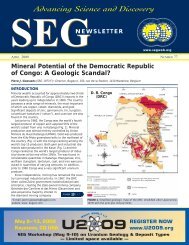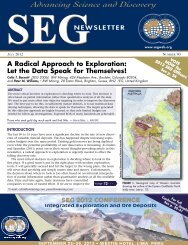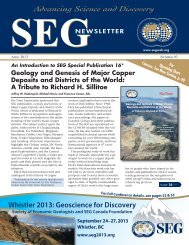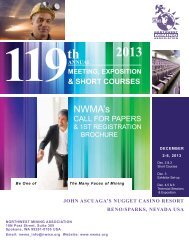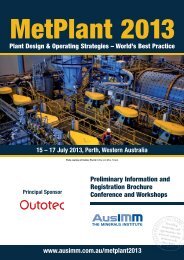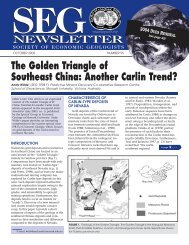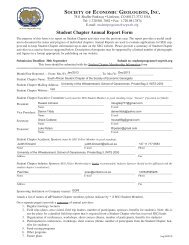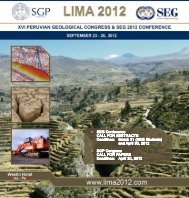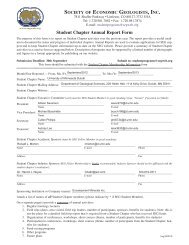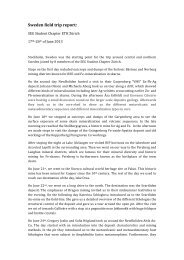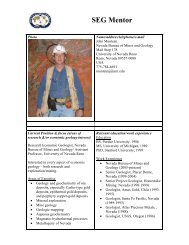SEG 45 Final_qx4 - Society of Economic Geologists
SEG 45 Final_qx4 - Society of Economic Geologists
SEG 45 Final_qx4 - Society of Economic Geologists
Create successful ePaper yourself
Turn your PDF publications into a flip-book with our unique Google optimized e-Paper software.
14 <strong>SEG</strong> NEWSLETTER No 53 • APRIL 2003<br />
... from 13<br />
Hydrothermal Monazite and Xenotime Geochronology (Continued)<br />
depositional age (1863 ± 7 Ma) <strong>of</strong> the<br />
host graywacke. Older detrital zircons<br />
were also recorded. Another group <strong>of</strong><br />
concordant zircon analyses was interpreted<br />
to be <strong>of</strong> hydrothermal grains,<br />
because their mean 207 Pb/ 206 Pb age <strong>of</strong><br />
1817 ± 16 Ma is similar as that<br />
obtained from monazite and xenotime<br />
grains (1810 ± 10 Ma). Interestingly, the<br />
monazite analysed by Compston and<br />
Matthai (1994) has a wide range <strong>of</strong><br />
both U concentrations (350 ppm to over<br />
2,500 ppm) and individual ages, which<br />
include older (~1900 Ma) and younger<br />
(1831–1624 Ma) analyses (see discussion<br />
in Şener et al., in press). Despite<br />
this variability, and in the absence <strong>of</strong><br />
petrographic control, all phosphate<br />
grains were interpreted by the authors<br />
to belong to the same generation and to<br />
be related to gold mineralization. The<br />
similarity <strong>of</strong> the dates <strong>of</strong> the interpreted<br />
hydrothermal zircon, monazite, and<br />
xenotime with that <strong>of</strong> the Cullen<br />
Batholith (1835 Ma to 1800 Ma; Stuart-<br />
Smith et al., 1993) was used to support<br />
the genetic relationship between gold<br />
mineralization and felsic magmatism.<br />
More recent dating <strong>of</strong> hydrothermal<br />
monazite (Şener et al., in press) does not<br />
support the results obtained by<br />
Compston and Matthai (1994).<br />
Monazite associated with pyrite and<br />
gold in a quartz vein (Fig. 3B) from the<br />
Goodall gold deposit was analysed in<br />
situ. The Goodall monazite grains are<br />
generally low in U (110–730 ppm), and<br />
the mean 207 Pb/ 206 Pb age <strong>of</strong> ca. 1.75<br />
Ga, despite a large uncertainty (±40 Ma<br />
due to the low U contents), indicates<br />
that gold mineralization postdates the<br />
Cullen batholith. In the light <strong>of</strong> these<br />
recent results, Şener et al. (in press) suggest<br />
that the phosphate grains analysed<br />
by Compston and Matthai (1994) could<br />
have included older contact-metamorphic<br />
grains that were incorporated into<br />
the vein during its formation. Contactmetamorphic<br />
monazite and xenotime<br />
from this area have been analyzed by<br />
SHRIMP and have similar mean<br />
207Pb/ 206 Pb ages (1833–1814 Ma;<br />
Rasmussen et al., 2001) to that<br />
obtained by Compston and Matthai<br />
(1994).<br />
Ghana<br />
Gold in Ghana is produced from either<br />
paleoplacer (e.g., Tarkwa) or orogenic<br />
gold deposits, including the giant<br />
Obuasi deposit (e.g., Oberthür et al.,<br />
1994; Allibone et al., 2002). Initially, it<br />
was suggested that the paleoplacer deposits<br />
were produced from weathering<br />
and erosion <strong>of</strong> the lode gold deposits<br />
(e.g., Kesse, 1985). However, detailed<br />
structural and geochronological studies<br />
negate this (e.g., Allibone et al., 2002).<br />
At the Damang gold deposit, epigenetic,<br />
orogenic-style gold mineralization<br />
clearly overprints low-grade paleoplacer<br />
hematite-magnetite gold occurrences in<br />
Tarkwaian-age conglomerates (Pigois et<br />
al., in press). Hydrothermal xenotime<br />
(Fig. 1E) intergrown with hydrothermal<br />
biotite and Fe carbonate in alteration<br />
halos around auriferous quartz veins in<br />
both conglomerate and basalt has been<br />
dated using SHRIMP. The xenotime date<br />
(2063 ± 9 Ma; Pigois et al., in press) provides<br />
the first precise age constraint for<br />
orogenic gold in Tarkwaian rocks.<br />
IMPLICATIONS FOR EXPLORATION<br />
Monazite and xenotime have been<br />
shown to provide robust, precise geochronometers<br />
applicable to the dating<br />
<strong>of</strong> orogenic gold deposits. Understanding<br />
the temporal framework for ore-systems<br />
contributes significantly to genetic and<br />
exploration models, and provides a<br />
sound basis for comparative studies<br />
between different ore systems. A precise<br />
age for any mineralization event also<br />
provides a means for direct correlation<br />
with the local and regional geological<br />
and tectonic history. It can form a basis<br />
for identification <strong>of</strong> critical associations<br />
that can be used in exploration programs<br />
at all scales, and the prospectivity<br />
<strong>of</strong> terranes, rock sequences, and<br />
structures <strong>of</strong> different ages can be better<br />
assessed. For example, a consequence <strong>of</strong><br />
the lack <strong>of</strong> temporal relationship<br />
between gold mineralization and felsic<br />
magmatism in the Pine Creek orogen<br />
(Şener et al., in press) is that exploration<br />
should not be restricted to contact<br />
aureoles <strong>of</strong> granites such as the<br />
Cullen batholith. In other cases, confirmation<br />
<strong>of</strong> a temporal relationship<br />
between mineralization and a particular<br />
suite <strong>of</strong> granitoids might provide a<br />
critical exploration indicator.<br />
Chemical classification <strong>of</strong> phosphate<br />
minerals can also allow correlation <strong>of</strong><br />
xenotime <strong>of</strong> different ages with different<br />
events within the same area. As such,<br />
there is the potential for unravelling,<br />
both temporally and genetically, complex<br />
multistage deposits.<br />
CONCLUSION<br />
Hydrothermal monazite and xenotime<br />
are common accessory minerals in<br />
orogenic gold deposits formed under a<br />
range <strong>of</strong> temperatures and pressures,<br />
and are commonly intimately associated<br />
with ore or ore-related alteration<br />
minerals. In many places monazite and<br />
xenotime coexist, thus allowing for a<br />
multimineral approach to dating <strong>of</strong><br />
mineralization. Such an approach can<br />
confirm the isotopic robustness <strong>of</strong> either<br />
phase, and provide extra confidence in<br />
the final calculated date. Phosphate<br />
dating complements existing<br />
geochronometers and adds an important<br />
and common mineral group to the<br />
list <strong>of</strong> datable minerals currently used<br />
to constrain the timing <strong>of</strong> ore formation<br />
in a variety <strong>of</strong> settings.<br />
ACKNOWLEDGMENTS<br />
The authors thank S.M. Brown, G.C.<br />
Dawson, G.L. England, C. Grainger, N.<br />
Kositcin, J-P. Pigois, K.C.J. Pires, B.P.<br />
Salier, A.K. Şener, F.H.B. Tallarico, and<br />
D.A. Vallini for access to results prior to<br />
publication. Staff <strong>of</strong> the CMM at UWA,<br />
Marion Marshall, AMIRA and ARC support<br />
is acknowledged. The manuscript<br />
benefited from detailed and constructive<br />
comments by J.K. Mortensen, J.<br />
Richards, R. Vielreicher, N. White, and<br />
an anonymous reviewer.<br />
REFERENCES<br />
Aleinik<strong>of</strong>f, J.N., and Grauch, R.I., 1990, U–Pb<br />
geochronologic constraints on the origin <strong>of</strong><br />
an unique monazite-xenotime gneiss, New<br />
York: American Journal <strong>of</strong> Science, v. 290,<br />
p. 522–546.<br />
Allibone, A.H., McCuaig, T.C., Harris, D.,<br />
Etheridge, M., Munroe, S., Byrne, D.,<br />
Amanor, J., and Gyapong, W., 2002,<br />
Structural controls on gold mineralization<br />
at the Ashanti deposit, Obuasi, Ghana, in<br />
Goldfarb R.J., and Nielsen, R.L., eds.,<br />
Integrated methods for discovery: Global<br />
exploration in the twenty-first century:<br />
<strong>Society</strong> for <strong>Economic</strong> <strong>Geologists</strong> Special<br />
Publication 9, p. 65–93.<br />
Brown, S.M., Fletcher, I.R., Stein, H.J., Snee,<br />
L.W., and Groves, D.I., 2002, Geochronological<br />
constraints on pre-, syn- and post-mineralization<br />
events at the Cleo deposit, Eastern<br />
Goldfields province, Western Australia:<br />
<strong>Economic</strong> Geology, v. 97, p. 541–559.<br />
Bruhn, F., Moeller, A., Sie, S.H., and Henson,<br />
B.J., 1999, U-Th-Pb chemical dating <strong>of</strong><br />
monazites using the proton microprobe:<br />
Nuclear Instruments and Methods in<br />
Physics Research, v. B158, p. 616–620.



